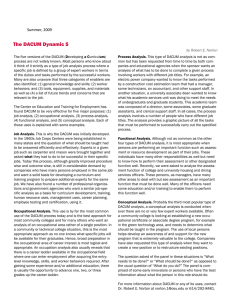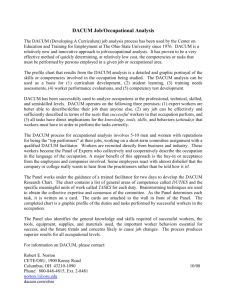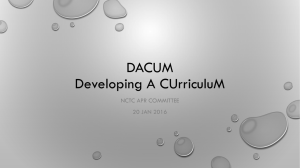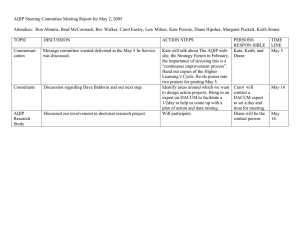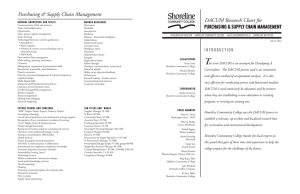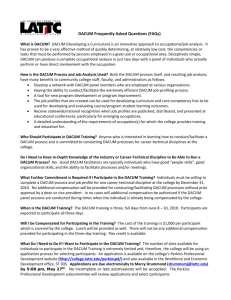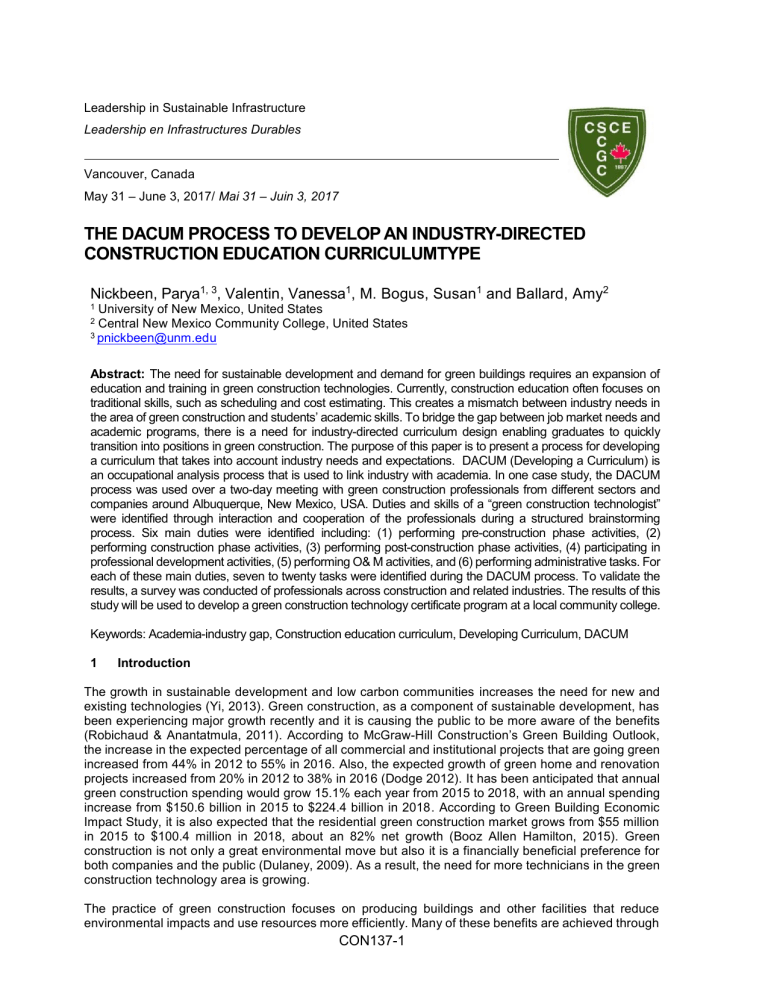
Leadership in Sustainable Infrastructure Leadership en Infrastructures Durables Vancouver, Canada May 31 – June 3, 2017/ Mai 31 – Juin 3, 2017 THE DACUM PROCESS TO DEVELOP AN INDUSTRY-DIRECTED CONSTRUCTION EDUCATION CURRICULUMTYPE Nickbeen, Parya1, 3, Valentin, Vanessa1, M. Bogus, Susan1 and Ballard, Amy2 1 University of New Mexico, United States Central New Mexico Community College, United States 3 pnickbeen@unm.edu 2 Abstract: The need for sustainable development and demand for green buildings requires an expansion of education and training in green construction technologies. Currently, construction education often focuses on traditional skills, such as scheduling and cost estimating. This creates a mismatch between industry needs in the area of green construction and students’ academic skills. To bridge the gap between job market needs and academic programs, there is a need for industry-directed curriculum design enabling graduates to quickly transition into positions in green construction. The purpose of this paper is to present a process for developing a curriculum that takes into account industry needs and expectations. DACUM (Developing a Curriculum) is an occupational analysis process that is used to link industry with academia. In one case study, the DACUM process was used over a two-day meeting with green construction professionals from different sectors and companies around Albuquerque, New Mexico, USA. Duties and skills of a “green construction technologist” were identified through interaction and cooperation of the professionals during a structured brainstorming process. Six main duties were identified including: (1) performing pre-construction phase activities, (2) performing construction phase activities, (3) performing post-construction phase activities, (4) participating in professional development activities, (5) performing O& M activities, and (6) performing administrative tasks. For each of these main duties, seven to twenty tasks were identified during the DACUM process. To validate the results, a survey was conducted of professionals across construction and related industries. The results of this study will be used to develop a green construction technology certificate program at a local community college. Keywords: Academia-industry gap, Construction education curriculum, Developing Curriculum, DACUM 1 Introduction The growth in sustainable development and low carbon communities increases the need for new and existing technologies (Yi, 2013). Green construction, as a component of sustainable development, has been experiencing major growth recently and it is causing the public to be more aware of the benefits (Robichaud & Anantatmula, 2011). According to McGraw-Hill Construction’s Green Building Outlook, the increase in the expected percentage of all commercial and institutional projects that are going green increased from 44% in 2012 to 55% in 2016. Also, the expected growth of green home and renovation projects increased from 20% in 2012 to 38% in 2016 (Dodge 2012). It has been anticipated that annual green construction spending would grow 15.1% each year from 2015 to 2018, with an annual spending increase from $150.6 billion in 2015 to $224.4 billion in 2018. According to Green Building Economic Impact Study, it is also expected that the residential green construction market grows from $55 million in 2015 to $100.4 million in 2018, about an 82% net growth (Booz Allen Hamilton, 2015). Green construction is not only a great environmental move but also it is a financially beneficial preference for both companies and the public (Dulaney, 2009). As a result, the need for more technicians in the green construction technology area is growing. The practice of green construction focuses on producing buildings and other facilities that reduce environmental impacts and use resources more efficiently. Many of these benefits are achieved through CON137-1 energy and water conservation and through the use of recycled or renewable materials (Liming 2015). In some construction sectors, the retrofitting of older buildings to be more sustainable is even outpacing the construction of new green buildings (Jergler 2011). Because most of the energy consumption in a building occurs during the operation phase (Menassa 2011), there is significant potential for transforming existing facilities to accomplish energy efficiency objectives (Bruce et al. 2015) through green retrofits. In New Mexico, several initiatives including the Build Green NM program and tax incentives are leading the way for more growth in the green construction sector. According to the Bureau of Labor Statistics, however, these types of green construction jobs require skilled workers with knowledge of new design and construction techniques (Liming 2015). The expansion of sustainable development and low carbon communities raises the need for new and existing technologies (Yi, 2013). Although the appearance of green construction projects is almost the same as non-green ones, they are much different in their material, design, and construction techniques (Liming, 2014). To apply these techniques and changes to construct a green building, it is essential that designers and engineers have an inclusive knowledge and skills to make all parts of a building work together in a green and efficient way. This fast-growing green construction sector has an unmet need for more experts to apply green knowledge in building construction. Consequently, in order to relieve this bottleneck, one change that the construction industry can make is to add new green job titles or modify existing occupations. 2 Background A gap between industry and academia has led to a slow transition of graduates from education to practice. Researchers have worked to identify, understand, and bridge this gap. Zaharim et al. (2009) studied the gap between industry perception and expectation of engineering graduates. They conducted a survey and set of face-to-face interview sessions with high ranking personnel from 422 companies in six industrial sectors. Both technical and non-technical abilities in terms of thirteen competencies were studied. The results indicate gaps between all technical and non-technical skills with the highest break occurring in engineering problem solving and effective communication skills in engineering graduates. As a solution to meet industry requirements, they suggest that the results be used by academia to improve and develop engineering curriculum. In another study, Ahn. et al. (2012) conducted a survey of 100 construction companies located in the Eastern U.S. to understand their expectations from construction graduates. The companies were asked to rate 14 key competencies of construction graduates and the result was compared with curriculum accreditation areas. By using a descriptive statistic and exploratory analysis among the data gathered from companies, they expressed that ethical issues, problem solving, and interpersonal abilities are the key competencies. They suggest that academia add more capabilities to their curriculum to not only cover industry requirements, but also to lead the industry in innovation. Radermacher and Walia (2013), conducted a systematic literature review to identify if there is any empirical evidence of knowledge deficiencies in graduating computer science students. The results show a gap between industry expectations and graduates’ knowledge in different areas such as technical abilities, personal skills, and professional qualities. They are suggesting changes to the existing curriculum in order to cover these missing skills. There are several methods to develop curricula at the college and university level. Brandenburger et al. (2016) used talking circles in order to gather information for developing a nutrition and physical activity curriculum in South Dakota. Finotto et al (2013) considered the necessity of Evidence-Based Practice (EBP) in nursing and the existence of associated skills in the curriculum. In this case, an anonymous survey was conducted and the results confirmed the importance of developing the current curriculum by including the laboratory’s three-year EBP. Grigg et al. (2005) proposed developing a curriculum based on information technology dynamic changes in Civil Engineering. The results of analyzing the data, which were gathered from literature review, conducting surveys of educators, and focus groups, indicates that information technology tools need to be included in civil engineering curricula. They also extracted obstacles by having participants discuss their experience. Lozano and Lozano (2014) used a combination of Concept Maps (CM) and quasi quantitative assessment of STAUNCH methods in order to analyze the data gathered from lecturers’ opinions in different disciplines and reviewed the courses offered in a Triple Bottom Line (TBL) “environment, economic, and social dimension” to develop a bachelor’s degree in engineering for sustainable development. CON137-2 Based on this previous research, there appears to be a need for industry-academia interaction to help academia develop an appropriate curriculum to meet industry requirements. A common method to recognize and understand industry expectations in terms of skills is job analysis. Job analysis is a process to identify a job’s requirements by experts who gather data and make decisions on that specific job (Clifford, 1994). The result of this process would be the job’s duties, responsibilities, skills, knowledge, and requirements and it would be the first step in order to provide a job’s description while having the vision of required training for doing it (Morganson et al., 2009). There are two types of job analysis methods: (1) job-oriented methods, which concentrate on the job, tasks, and activities in a position, and (2) worker-oriented methods, which focus on the required competencies in accomplishments on the job by the worker (Cucina, et al. 2013). There are several methods to conduct job analysis. These methods are categorized as interview methods, survey methods, convened group techniques, and miscellaneous techniques. The related methods and categories are presented in Table 1 (Carnaghan, 2003). Table 1: Occupational Analyses Methods (Carnaghan, 2003) Categories Interview Survey Convened group techniques Miscellaneous Techniques Techniques Competencies interviews Critical incident technique General survey Delphi Nominal group technique DACUM (develop a curriculum) Search conference Functional analysis Comprehensive Occupational Data Analysis Programs (CODAP) Observation Job competency assessment (McBer) Researchers have used observations, surveys, worker diaries, questionnaires, critical incidents, interviews - both individual and focus groups - as job analysis techniques (Shetterly and Krishnamoorthy, 2008) The competency tasks and activities identification would be highly reliable if the job analysis is performed by the professionals from specialized industries, because of their experience and knowledge in performing the job (Dixon and Stricklin, 2014). The Developing a Curriculum (DACUM) process is one technique for performing job analysis, and it is used here to identify a green construction technologist profile as it is time-efficient and provides high quality results. 3 Methodology The first references to DACUM were in 1966 where it began as a new approach to curriculum development with the Iowa Job Corps in Clinton, Iowa, USA. Then it was used by the Nova Scotia New Start Inc, in 1968. DACUM was adopted by Holland College in Charlottetown P.E.I Canada, in 1969 through the efforts of the president, Donald Glendenning and program specialist Larry Coffin (Norton and Moser, 2008). DACUM is an acronym for developing a curriculum and is a one-day or two-day storyboarding process that provides a picture of what the worker does in terms of duties, tasks, knowledge, skills, traits and in some cases the tools the worker uses. The information is presented in graphic chart form and can include information on critical and frequently performed tasks and the training needs of workers. (DACUM organization, 2016; Bernardus Sentot, 2014) The main question to be answered by DACUM is “what are the required skills and knowledge to perform a specific occupation at a certain proficiency level?”. Theoretical knowledge, practical skills, and personal behaviors are explored through the DACUM process in order to assist a person to perform an occupation completely (Zanella, 1999). According to the DACUM handbook by Norton (1992), DACUM is based on three principals including: CON137-3 - To define or describe a job, experts workers in that position are the best ones; - Competent/successful workers, who perform the tasks, can effectively describe them; - To perform each task, particular attitudes and knowledge are required. A DACUM committee is composed of 8-12 expert workers in a specific job position from a directly related industry, business, and/or organization. These experts are outstanding in their particular occupations, so they do not need advance preparation for these meetings. The facilitators guide the committee members in two days of meeting to develop the DACUM chart showing the involved competency duties and tasks to perform a specific occupation. (Robert, 1960; Zanella, 1999) The DACUM workshop usually starts with an orientation to inform the attendants about the DACUM process. Folllowing Dixon & Stricklin (2014), other steps include: 1. Primary brainstorming of general idea about occupation 2. Providing structural chart which graphically shows duties and tasks performed by workers for the specific occupation. 3. Identifying all duties of the occupation 4. Brainstorming to identify specific tasks related to duties 5. Identifying all tasks 6. Finalizing and getting all member’s approval on all tasks and duties 7. Reviewing primary brainstorming and modifying duties and tasks 8. Putting tasks and duties in order in terms of importance and sequences 9. Identifying general required knowledge and skills to perform the occupation 10. Identifying required tools, equipment, and materials 11. Providing a list of all acronyms and not known terms used in the chart. In this study, a panel of 9 professionals from companies with a focus on green construction were selected to participate in the DACUM process. The panel included three architects, a training director, an electrical/PV Contractor, a BIM director, a BIM specialist, and a principal engineer. A two-day meeting was facilitated by two representatives from the Central New Mexico Community College (CNM) to identify the green construction technologist’s requirements from the industry point of view. The meeting began with an introduction of DACUM process which included the goals of the process and an overview on how the results should look like. The facilitators systematically guided the participants through a brainstorming process in which main duties and tasks - competencies necessary to perform the job – were identified. When there were conflicts or disagreement between participants the facilitator instructed them to debate in order to achieve consensus and complete the process. One of the facilitators was constantly recording duties, tasks statements, relevant knowledge, primary tools, and applications on cards that were displayed and visible to the participants all the time. This process is important, since the cards were then replaced or moved into a more acceptable position in the order of their importance and priority (Halasz et al., 1994). Then the participants are asked to discuss the priority and importance of each duty and relevant tasks. To validate the results of this process, a survey was developed and sent to additional green construction professionals. The survey was based on a Likert rating from 1, not important, to 5, very important, asking the professionals to rate the importance of the duties and tasks. 4 Results The results of the DACUM process include skills, knowledges, tools, and behaviors for a specific occupation presented in a graphic chart. In Tables 2 and 2b the duties and tasks are shown with the order of their importance including: (A) performing pre-construction phase activities, (B) performing construction phase activities, (C) performing post-construction activities, (D) performing O & M related activities, (E) participation in professional development activities, and (F) performing administrative activities respectively. For instance, the most important duty for the green construction technologist position is performing pre-construction phase activities. Each duty holds a variety of tasks that are identified and sorted in order of their necessity and importance to perform the duty. During the DACUM process, since the number of identified tasks was different and relatively high – from 4 to 20 – it was hard to prioritize them with agreement of all participants. At first it was assumed that doing the LEED certification related tasks would play the most important role in this position, while after identifying all CON137-4 tasks, the participants agreed that it is in next level of importance. As it is shown in Table 2a, researching building project constraints (A.1) is more important than researching Authority Having Jurisdiction (AHJ) (A.2) and coordinating LEED related activities (A.3) to perform pre-construction phase activities as a duty at the final review. Also, there were many tasks statement identified at the beginning of the brainstorming stage that at the end were eliminated since the participants decided that those tasks are not relevant. For instance, installing data analyzers was initially identified as one of the pre-construction phase activities’ tasks, and after the final discussion it was not recognized as a necessary task to perform in the position. . Also, there were some tasks that could be part of two different duties such as Identify green marketing opportunities that could be a task for both preforming pre-construction phase activities and performing administrative activities. Table 2a: Duties and Tasks identified in DACUM process to perform green construction technologist responsibilities Duties Tasks A. Perform Pre-Construction Phase A.1 Research building project constraints Activities A.2 Research AHJ (Authority Having Jurisdiction) and applicable codes A.3 Coordinate LEED (Leadership in Energy and Environmental Design) related activities A.4 Document existing project site conditions A.5 Evaluate site designs A.6 Assist with building energy and daylight models A.7 Perform water use and collection calculations A.8 Research green certifications A.9 Research sustainability grants, tax credits and rebates A.10 Distribute project team contact and correspondence list A.11 Participate in project team meetings A.12 Prepare project team meeting minutes A. 13 Integrate green solutions recommendations into design and BIM (Building Information Modeling) documentation A.14 Perform BIM coordination A.15 Assist with selection of green materials and systems A.16 Prepare green materials list A.17 Edit project specifications A.18 Prepare waste management construction plan A.19 Prepare Air Quality Construction Plan A.20 Assist with SWPPP(Storm-water Pollution Prevention Plan) coordination B. Perform Construction Phase Activities B.1 Perform submittal review (products, equipment, systems) B.2 Assist with permit process B.3 Distribute commissioning plan and checklist B.4 Verify received materials B.5 Track green materials B.6 Assist with coordination of green trades B.7 Manage construction waste plan B.8 Assist with construction checklist verification B.9 Manage IAQ (Indoor Air Quality) plan B.10 Assist with Compliance documentation B.11 Assist with systems performance testing (e.g., HVAC -Heating, Ventilation and Air Conditioning-, plumbing, lighting) B.12 Assist with envelope performance testing (e.g., windows, air barrier) B.13 Collect SWPPP event reports CON137-5 B.14 Input facility management systems-related data B.15 Perform flushout calculations C. Perform Post-Construction Phase Activities C.1 C.2 C.3 C.4 C.5 C.6 C.7 C.8 C.9 Document air quality flushout plan Update energy management plan Help coordinate submittal data for O & M manuals Compile construction phase report for commissioning agent (e.g., substantial completion, record drawings, T & B report) Upload documents to LEED online Update standards with lessons learned (e.g., company owner) Implement green signage Establish O & M (Operations and Maintenance) points of contact Document building performance goals Table 2b: Duties and Tasks identified in DACUM process to perform green construction technologist responsibilities Duties Tasks D. Perform O & M Related D.1 Maintain O & M and project team points of contact Activities D.2 Train O & M staff in green practices (e.g., soap, cleaning supplies) D.3 Track utility performance (e.g., gas, water, electrical) D.4 Report actual building occupancy D.5 Set up data loggers D.6 Validate EMS (Energy Management System) set points D.7 Educate occupants on building sustainability plan D.8 Oversee building recycling plan D.9 Verify use of green consumables D.10 Conduct building sustainability performance review D.11 Maintain list of building performance related issues D.12 Maintain LEED compliance documents D.13 Assist with third party audits E. Participate in Professional Development Activities F. Perform Administrative Tasks E.1 Develop personal professional development plan E.2 Complete professional certifications (e.g., LEED GA, BOC (Building Operating Certificate),CDT(Construction Document Technologist)) E.3 Participate in continuing education activities E.4 Facilitate continuing education activities E.5 Participate in code update training E.6 Participate in BIM related software training E.7 Compile list of company best practices E.8 Participate in professional organizations E.9 Participate in mentoring activities E.10 Participate in conferences and trade shows E.11 Facilitate community outreach activities E.12 Assist with smart technology feasibility studies F.1 Maintain green product library F.2 Assist with development of materials to market green practices F.3 Identify green marketing opportunities F.4 Maintain standard green specifications Additionally, the general skills and knowledge to perform related duties are shown in Table 3. These skills are fundamental industry expectations for a green construction technologist. Some of these skills, including familiarity with green and energy codes and standards, functional aspects of CON137-6 landscaping and plant choice, and some computer skills have not had enough attention in current construction-related curricula. Tools, equipment, supplies and materials needed to perform associated responsibilities that resulted from the DACUM process encompass: airflow hood, azimuth tool, augmented reality tools (e.g. Daqri), blower door, cell phone, cellphone apps, CO2 sensor, data logger, duct blaster, infrared scanner, laser level, light meter, measuring tools (e.g. tape measure), solmetric sun eye, sUAS (Small Unmanned Aircraft Systems), tablet-based applications, and temperature sensor. The expected behavior of a green construction technician includes being: detail oriented, collaborative, analytical, punctual, observant, self-motivated, perseverance, confident, responsible, professional attire, initiative, and have passion for sustainability. Most of these be havioral attributes are expected almost in all positions, while they have received less attention in academia. The results show a need for developing a curriculum to cover all the industry expectations for a green construction technologist. To validate the results, a survey is in progress. Table 3: General knowledge and skills identified in DACUM process to perform green construction technologist responsibilities General Knowledge and Skills Computer Skills: Spreadsheets Apps Internet research Microsoft Office type tools Data (obtain, organize) Multi-device and media aptitude Electronic communication protocol (e.g., email vs. texts) Knowledge of design and construction industry General knowledge of construction trades Technical writing Basic understanding of building science Ability to read construction documents LEED GA Certification OSHA for Construction certification Energy basics Construction specification formats Familiarity with green and energy codes and standards BOC Time management skills Presentation skills Functional aspects of landscaping and plant choice Sustainability theory and philosophy 5 Conclusions There is a growing need for technicians in green construction which requires academia to provide the necessary education for students to help them to quickly transition to industry. In this study, the DACUM method is used to link academia and industry. In a two-day brainstorming process for the DACUM, necessary duties, tasks, general knowledge, tools, and behavior were identified. Six main duties are identified and prioritized in order of their importance, then for each duty several tasks are presented. General knowledge, behavior, and tools are discussed and introduced. A survey will be conducted to validate these identified duties and tasks for the green construction technologist position. Then, the next step will be further studying and reviewing existing curricula to confirm their competencies coverage extent and to explore their differences from the result of this study. The results of this study contribute knowledge and provide a resource for both academia, to develop a curriculum, and industry, to have documented requirements of the green construction technologist position. CON137-7 Although the DACUM process has been a reliable method to develop a curriculum, there are some limitations in this study. More than 30% of the professional participants in the tow-day brainstorming meeting had an architectural background which may have led the results to be more related to their field. Moreover, the number of participants is limited for the DACUM process . Another limitation could be that the DACUM process is not capable of observing the infrequent tasks and duties that need personal judgement in a job. But, by interviewing the job holder, this limitation can be overcome. The committee members are from industries, businesses, and organizations in Albuquerque, NM. To generalize these results, a similar study could be performed in other areas. 6 References Ahn, Y. H., Annie, R. P., & Kwon, H. (2012). Key competencies for US construction graduates: Industry perspective. Journal of Professional Issues in Engineering Education and Practice, 138(2), 123-130. Bernardus Sentot, W. (2014). Comparison between the DACUM and Work Analysis for vocational. International Conference on Vocational Education and Training (ICVET) , 53–58. Booz A. H. (2015). Green Building Economic Impact Study, U.S. Green Building Council, v. Boritz, J. E., & Carnaghan, C. A. (2003). Competency‐Based Education and Assessment for the Accounting Profession: A Critical Review. Accounting Perspectives, 2(1), 7-42. Chang, C. C. (2014). Obtaining IT competencies for curricular development using Qtechnique. International Journal of Academic Research in Business and Social Sciences, 4(3), 60. Consoli, D., Marin, G., Marzucchi, A., & Vona, F. (2016). Do green jobs differ from non-green jobs in terms of skills and human capital?. Research Policy, 45(5), 1046-1060. Cucina, J. M., Caputo, P. M., Thibodeaux, H. F., Maclane, C. N., & Bayless, J. M. (2013). Scoring Biodata : Is it rational to be. International Journal of Selection and Assessment, 2(2). Dixon, R. A., & Stricklin, L. S. (2014). Lessons learned using the modified DACUM approach to identify duties and tasks for CADD technicians in North Central Idaho. Online Journal for Workforce Education and Development, VII(1). Dulaney, D. (2009). 2009 Greening of Corporate America. Dodge Data & Analytics (2012). 2013 Dodge Construction Green Outlook Report, McGraw -Hill Construction. Fook, S., Eng, P., & Ping, F. (2013). Development of ICT Competency Standard Using the Delphi Technique. Procedia Social and Behavioral Sciences, 103, 299–314. http://doi.org/10.1016/j.sbspro.2013.10.338 Halasz, I. M., & Reid, T. (1994). Overview of DACUM job analysis Process. Longmont: NIC Academy Division. Johnson, J. (2010). What GIS Technicians Do : A Synthesis of DACUM Job Analyses, (Gisci). Jergler, D. (2011). “Green Retrofitting Surpasses New Green Construction for First Time. ”Insurance Journal. <http://www.insurancejournal.com/news/national/2011/12/09/226746.htm>. Date accessed: May 10, 2012 Jones, E. A., & Voorhees, R. A. (2002). Defining and Assessing Learning: Exploring Competency-Based Initiatives. Report of the National Postsecondary Education Cooperative Working Group on Competency-Based Initiatives in Postsecondary Education. Brochure [and] Report. Lim, Z., Anderson, C., & Mcgrath, S. (2012). International Journal of Educational Development Professional skills development in a resource-poor setting : the case of pharmacy in Malawi. International Journal of Educational Development, 32(5), 654–664. http://doi.org/10.1016/j.ijedudev.2012.01.004 Liming, D. (2014). Careers in Green Construction. Retrieved from: http://www.bls.gov Liming, D. (2015). Careers in Green Construction. Retrieved from: http://www.bls.gov/green/construction/ Menassa, C. C. (2011). "Evaluating sustainable retrofits in existing buildings under uncertainty."ENERGY AND BUILDINGS, 43(12), 3576-3583. Robert, E. (1960). Norton Senior Research and Development Specialist: DACUM COORDINATOR’S HANDBOOK. The National Academy Vocational Education. The Ohio State University, 2-24. Robichaud, L. B., & Anantatmula, V. S. (2010). Greening project management practices for sustainable construction. Journal of Management in Engineering, 27(1), 48-57. CON137-8 Sandberg, J., & Pinnington, A. H. (2009). Professional Competence as Ways of Being : An Existential Ontological Perspective, (November). http://doi.org/10.1111/j.1467-6486.2009.00845.x Shetterly, D. R., & Krishnamoorthy, A. (2008). Job characteristics of officers and agents: Results of a national job analysis. Public Personnel Management, 37(1), 111-131. Yi, H. (2013). Clean energy policies and green jobs : An evaluation of green jobs in U. S. metropolitan areas. Energy Policy, 56, 644–652. http://doi.org/10.1016/j.enpol.2013.01.034 Zaharim, A., Yusoff, Y. M., Omar, M. Z., Mohamed, A., Muhamad, N., & Mustapha, R. (2009). Perceptions and expectation toward engineering graduates by employers: a Malaysian study case. WSEAS Transactions on Advances in Engineering Education, 6(9), 296-305. Zanella, D. J. (1999). Analysis of the Industrial Technology Electrical Systems Specialization Using DACUM Analysis of the Industrial Technology Electrical Systems Specialization Using DACUM. Journal of Industrial Technology, 15(4), 1–6. CON137-9
